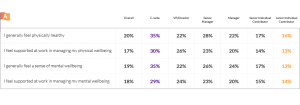We’ve all heard that “reading is fundamental.” We’re going to tweak that adage a bit for email marketers and coin a new one: “readability is fundamental.”
In fact, it’s probably safe to say that in terms of importance to a campaign’s success, readability is right up there with deliverability, a topic we recently covered in our recent post about spam filters. Once you’ve ensured your email has arrived successfully, the next critical challenge is to make sure your message gets through clearly, and that your call to action (CTA) is clear and intuitive. Hence, the importance of readability.
Below are a few suggestions to help ensure the readability of your messages.
Making your writing readable: As easy as ABC
The covers of a popular brand of notebooks used by newspaper reporters are inscribed with the motto “Accuracy, Brevity, Clarity: the ABCs of good reporting.” If you apply the same three words to the development of your email copy, you are well on your way to success when it comes to readability.
So:
- Accuracy – Does your email successfully convey the message you want to deliver?
- Brevity – Is that message conveyed in the simplest, most understandable language possible
- Clarity – Is it clear to your recipients why your message is important and what actions you want them to take as a result of it?
“You don’t need convoluted grammar and SAT words to show you know your business,” writes communications consultant Elisa Silverman. “Your emails aren’t here to test your market’s reading comprehension skills. Short sentences and common words make for easy reading. Easy reading makes it easier to get your message across.”
Fortunately, determining how readable your emails doesn’t have to be a matter of guesswork – there are tools literally right at your fingertips to assess that. One way is to set the spelling/grammar check utility in Microsoft Word to measure two readability assessments: the Flesh-Kincaid Reading Ease score and Flesh-Kincaid Grade Level.
Silverman advises targeting a Reading Ease score of between 60 and 80 and a Grade Level score of below eighth grade. She stresses that “This doesn’t mean dumbing down your copy. Even the super-smarties of the world will find simple, clear writing easier to understand and will retain more of what they’ve read.”
Not a Microsoft Word user? Never fear, to check the readability of your message, just take your copy here.
And although you will no doubt put a lot of time and attention into your body copy, crafting an effective subject line is also critical to your message’s readability and overall impact. Here are five examples of subject lines you definitely want to avoid and 18 examples of “the best email subject lines you’ve ever read.”
Format for scanning
As we discussed in a recent post, it’s not our imagination – our attention spans are indeed getting shorter. Research has determined that the attention span of a human being is now about eight seconds – down from 12 seconds in 2000. (That puts humans in the same attention-span ballpark as the average goldfish.)
And here’s another statistic that makes that rather disturbing fact even more troubling for email marketers – researchers have determined that “on average, readers are spending 15-20 seconds on each email they open.”
And during that 15-20 seconds, your recipients aren’t actually reading your message; rather, they are scanning it to find information that is immediately relevant to them. So, it’s up to you to provide content that supports that quest.
To ensure scanability, consider including:
- Bulleted lists (like this one)
- Numbered lists
- Subheads (like those in this post)
- Bold and italic text
And, as we mentioned in our post about short attention spans, you can also help promote scanning by ensuring your copy “breathes” – employing short paragraphs and lots of white space can work wonders for helping to capture and retain your readers’ attention, because, according to editor Catherine Legg, “spaces draw attention to the writing in the same way that a frame draws attention to a picture.”
Readability on mobile devices
“Reading content from a mobile device is totally different from reading content on a desktop,” writes Neil Patel at the Content Marketing Institute – something that is very important to keep in mind now that more than half of all emails are opened on them.
Patel says that writing successfully for mobile consumption “requires a reorientation to the art of writing,” as well as a focus on responsive design. “Don’t write less. Write better,” he advises. “Mobile readers still read articles. In fact, they might read more content on their mobile devices.”
The “F-shape” pattern discovered by renowned usability expert Jakob Nielsen after he examined at how readers consume content on desktops needs to be reconsidered when it comes to mobile, Patel writes.
“The F-shaped reading pattern taught that users looked at the top, left to right, down, left to right, and then down further,” he writes. “This principle no longer applies in the era of mobile readers. There’s not enough screen real estate for horizontal sweeps and vertical movement,”
because on mobile devices, most of readers’ attention is squarely focused on the center and upper two-thirds of their screen.
So, for readability on mobile, make sure your most important content appears where most of your readers are going to see it – in the middle and high in your message.
Patel has additional tips for mobile readability, including:
- Use only images that advance your point, otherwise they will distract recipients
- Don’t use unnecessary words, phrases, sentences or points
- Create short, strong headlines that give the recipient a clear “what’s in it for me?” answer
- Front load your most powerful content
The bottom line
By incorporating these proven tips in your writing and formatting, you can ensure your emails are readable (however they are consumed) and that your CTA is clearly communicated to your recipients.
Digital & Social Articles on Business 2 Community(69)





